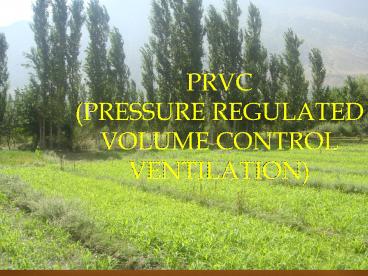PRVC mode of ventilation - PowerPoint PPT Presentation
Title:
PRVC mode of ventilation
Description:
Pressure regulated volume control mode of ventilation basics – PowerPoint PPT presentation
Number of Views:584
Title: PRVC mode of ventilation
1
PRVC(PRESSURE REGULATED VOLUME CONTROL
VENTILATION)
2
(No Transcript)
3
How PRVC works
- PRVC is a form of an adaptive pressure controlled
ventilation in which tidal volume is used as a
feed back control to continuously adjust the
pressure limit. - This adaptive mode of ventilation targets the
lowest inspiratory pressures to achieve the set
tidal volume. - Adaptive targeting system in PRVC is a great
asset in our ventilator toolbox. In most cases,
PRVC can deliver the desired tidal volume at the
lowest pressures, using the Adaptive targeting
scheme as a feedback method.
4
How PRVC works
- Assist-control ventilation ventilator initiated
(control breath) patient initiated (assist
breath) - Pressure limit is set within that set pressure
limit tidal volume is delivered. - ventilator adjusts pressure from breath to
breath, as patient's airway resistance and
respiratory system compliance changes, in order
to deliver the set tidal volume - ventilator monitors each breath and compares the
delivered tidal volume with the set tidal volume.
If the delivered volume is too low it increases
the inspiratory pressure on the next breath. If
it is too high it decreases the pressure
5
How PRVC Works
6
How Works
- The maximum allowed inspiratory pressure is 5 cm
H2O below the upper pressure alarm limit - The duration of inspiration is determined by the
respiratory rate and the IE ratio or inspiratory
time (ie this is a time-cycled mode of
ventilation)
7
Set Tidal Volume Varying Pressure during delivery
of TV
8
(No Transcript)
9
Settings
- Respiratory Rate
- Pts spontaneous RR lt set rate machine
gives additional control breaths - to make up difference ,pts spontaneous
- rate gt
- set rate no control breaths
10
Target tidal volume
- Initial setting 6-8 ml/kg Ideal body weight
based on height
11
PRESSURE
Ventilator delivers pressure of up to 5 cm H2O
below upper pressure alarm limit set to 35-40 cm
H2O to ensure "safe" pressures do not exceed
this setting without consulting an ICU specialist
12
FIO2
- Initially 100 except in case of some disease
where oxygen is contraindicated.FIO2 can be
tapered off according to Po2
IE ratio
- Initial setting 12 (inspiratory time of 33)
,consider longer inspiratory time if there is no
intrinsic PEEP, no bronchospasm and oxygenation
is poor
13
PEEP
- initial setting 5-10 cm H2O
- Trigger Sensitivity
- According to Situation
14
Introduction to various modes of mechanical
ventilation
15
Pressure - Volume Curve
Increased Compliance
Increased Resistance
Overdistension
16
Pressure - Time Curve
17
Table 1 Physiological variables during the two
modes of mechanical ventilation,
pressure-regulated pressure control (PRVC) and
volume control (VC) PRVC (n 44) VC (n
44) P PIP (cmH2O) 20 (19-23) 24 (23-27) lt
0.0001 MAIP (cmH2O) 10 (9-11) 10 (9-11) ns PaO2
(mmHg) 98 (93-111) 96 (92-108) ns PaCO2 (mmHg) 43
(40-46) 43 (40-46) ns pH 7.38 (7.11-7.65) 7.38
(7.10-7.65) ns MAP (mmHg) 76 (73-83) 77
(74-84) ns Values are means (95 confidence
limits). PIP peak inspiratory pressure MAIP
mean airway pressure PaO2 partial pressure of
arterial oxygen PaCO2 partial pressure of
arterial carbon oxide MAP me
US National Library of Medicine National
Institutes of Health
18
Table 2 Results of the general trial
PRVC (n 22) VC (n
22) P Days on ventilator 7.0 (3.8-10.3) 6.2
(3.8-8.5) ns Failing 0/22
2/22
ns Survival 12/22 11/22
ns Days on ventilator median
(95 confidence limits) number of days spent on
mechanical ventilation Failing number of
patients failing the assigned mode of
ventilation Survival survival in the two
groups.
19
Advantages
- Decelerating inspiratory flow pattern with
automatic adjustment of the inspiratory pressure
for changes in compliance and resistance
resulting in a guaranteed tidal volume
20
(No Transcript)
21
References 1 R.L. Chatburn, E. Mireles-Cabodevil
aClosed-loop control of mechanical ventilation
description and classification of targeting
schemes Respir. Care, 56 (1) (2011),
pp. 85-102 CrossRefGoogle Scholar 2 R.D. Branson
, R.L. ChatburnControversies in the critical care
setting. Should adaptive pressure control modes
be utilized for virtually all patients receiving
mechanical ventilation? Respir.
Care, 52 (4) (2007), pp. 478-485 discussion
485-478 View Record in ScopusGoogle
Scholar 3 H. Guldager, S.L. Nielsen, P. Carl, M.
B. SoerensenA comparison of volume control and
pressure-regulated volume control ventilation in
acute respiratory failure Crit. Care (Lond.
Engl.), 1 (2) (1997), pp. 75-77 View Record in
ScopusGoogle Scholar 4 S. Jaber, J.M. Delay, S.
Matecki, M. Sebbane, J.J. Eledjam, L. BrochardVol
ume-guaranteed pressure-support ventilation
facing acute changes in ventilatory
demand Intensive Care Med., 31 (9) (2005),
pp. 1181-1188 pp. 1623-1631
22
- Slustsky AS. ACCP consensus conference
mechanical ventilation. Chest. 199310418331859.
PubMed Google Scholar - Webb HH, Tierney DF. Experimental pulmonary
oedema due to intermittent positive pressure
ventilation with high inflation pressures.
Protection by positive end-expiratory pressure.
Am Rev Respir Dis. 1974199556565. PubMed
Google Scholar - Corbridge TC, Wood LD, Crawford GP, Chudoba JR,
Yanes J, Sznaider JL. Adverse effects of large
tidal volume and low PEEP in canin acid
aspiration. Am Rev Respir Dis. 1990142311315.
PubMed Google Scholar
23
SHAMS ALI SHAH RT PSCCQ
Your text here































